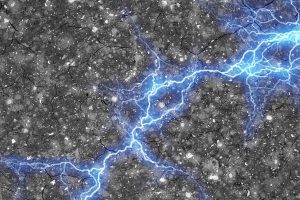
Engineers at the Massachusetts Institute of Technology have developed a type of cement that, with the addition of a commonly-available substance that has been used for centuries, can act as a super-capacitor, capable of storing a large amount of electrical energy. Since cement is already an ingredient of concrete, the material can be incorporated into buildings that are capable of storing electricity generated from renewable sources themselves, without having to rely on ecologically-destructive batteries.
The researchers found that when cement is combined with a substance called carbon black and water, a 3.5 meter (11.5-foot) cube of the resulting mixture, once set and cured, is capable of storing about 10 kilowatt-hours of energy, enough to power an average household for a day. This means that it wouldn’t take a great deal of the material to squirrel away a useful amount of energy produced by solar or wind power for use at night, or when the wind is absent.
Carbon black is a common material that is used as a pigment and reinforcing material in rubber tires; it has been used for centuries as a pigment in paints, and more recently in inks and plastics; and as a conductive additive in lithium-ion batteries. As the name might imply, it is composed of carbon, consisting of very fine particles with a very high surface area for their size, and is already produced in massive quantities for industrial use.
The other ingredient in the mix, cement, has been used for thousands of years—mixed with water and an aggregate such as gravel or sand—to produce the concrete used as a vital component in our civilization’s architecture and infrastructure; when combined with low-cost carbon black—the material can operate on just three percent carbon in the mix—the resulting material acts like a supercapacitor, a device capable of storing a large amount of electrical energy that can not only be discharged faster than ordinary batteries, but can also be recharged many more times than rechargeable batteries before its capacity starts to wane.
“The material is fascinating,” remarked Admir Masic, the principal investigator for MIT’s Concrete Sustainability Hub, “because you have the most-used manmade material in the world, cement, that is combined with carbon black, that is a well-known historical material—the Dead Sea Scrolls were written with it. You have these at least two-millennia-old materials that when you combine them in a specific manner you come up with a conductive nanocomposite, and that’s when things get really interesting.”
Masic explained that as the mixture sets and cures “the water is systematically consumed through cement hydration reactions, and this hydration fundamentally affects nanoparticles of carbon because they are hydrophobic (water repelling).” As the process unfolds “the carbon black is self-assembling into a connected conductive wire.”
Although the addition of more carbon black to the concrete increases its storage capacity, doing so does weaken the material somewhat, with a mixture of about 10 percent carbon black appearing to be the sweet spot in the balance between electrical storage and material strength. However, this ratio could be exceeded for structures that don’t require a great deal of strength, such as walkways or non-load bearing walls.
The researchers also expect that in addition to providing electrical storage in the very material that a building is constructed from, the supercapacitor material could also be used in roadways to charge electrically-powered vehicles as they travel. The concept is also scalable, allowing designers to draw as much—or as little—current as needed, by adjusting the size of the electrodes used to access the material’s energy.
“You can go from 1-millimeter-thick electrodes to 1-meter-thick electrodes,” explains MIT Professor of Civil and Environmental Engineering Franz-Josef Ulm, “and by doing so basically you can scale the energy storage capacity from lighting an LED for a few seconds, to powering a whole house.”
Subscribers, to watch the subscriber version of the video, first log in then click on Dreamland Subscriber-Only Video Podcast link.
Wow! Thanks for the article!
Outstanding. Thank you, Obi-Wan. I will mention your article to Dr. Mark Jacobson at Stanford.
I appreciate the articles you choose to share. This one is very interesting. I think it was Linda M-H who just mentioned the highway being electrified. Is there time?